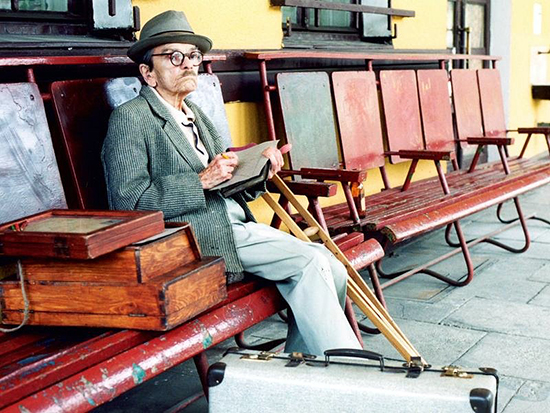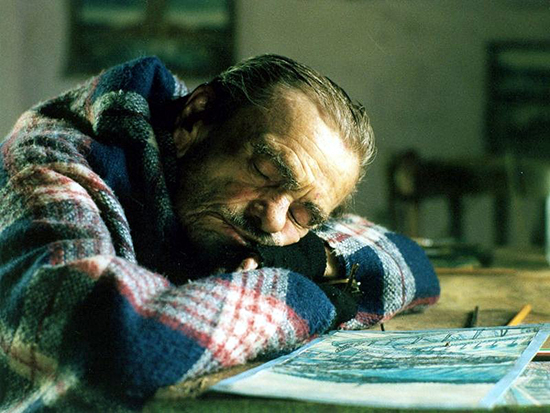On Friday September 14, 2007, three years after its premiere at the Gdynia Film Festival and eight months after the death of its star Krystyna Feldman, Mój Nikifor (‘My Nikifor’), the Polish-language biopic of a beloved (if little-known) folk artist opened at select UK cinemas. It gained a positive, if mild, response from British critics: Tom Dawson wrote for the BBC that it was “artfully composed… spare yet affecting.” Yet audiences that weekend were presumably more interested in the releases of James Mangold’s remake of 3:10 to Yuma, which opened to £400,000, and Superbad, which grossed a staggering £1.5 million on its way to a UK total above £6 million. In contrast, on its sole day of presentation at British cinemas in the first days of Autumn 2007, Mój Nikifor grossed just £7 – the equivalent to one ticket sold.
70 years before, in a 1938 issue of the Warsaw literary magazine Arkady, art critic Jerzy Wolff wrote of a poverty-stricken folk painter in Poland’s Southern mountains whose work he had recently seen in a friend’s Paris art studio. “These little pictures are as simple as nature; their uniqueness lies solely in truly seeing reality through eyes which are different from everybody else’s… His perfect sensitivity to colour reflects our own love of painting. There is greatness in Nikifor.”
Only months after that, the Second World War began in Poland and Nikifor’s native Łemko ethnic group were forcibly resettled, first by the occupying Red Army and later by the Soviet puppet government after the war. Nikifor was lucky to remain in the relatively prosperous spa village of Krynica-Zdrój, his home, but his rise to fame was swiftly halted, any remaining friends and family dispersed carefully across northern Poland and the USSR. All he had left was a tattered copy of Wolff’s review, which he framed and carried around his neck for the rest of his life, a reminder, in case all others had forgotten, that there was greatness in Nikifor.
The scope of director Krzysztof Krauze’s film is aimed long after the traumatic events of Nikifor’s austere mid-life, instead focusing on his final and most significant decade. Charting Nikifor’s life and work from 1960 until his death in 1968, Mój Nikifor begins at the outset of the troubled but talented painter’s fruitful working relationship with Marian Włosiński (Roman Gancarczyk). A jaded younger artist in his own right, Marian is at first a reluctant hand-holder to Nikifor, but grows to become his greatest friend and assistant, ultimately suffering consequences to his marriage with Hanna (Lucyna Malec), and to his reputation in a town that thought Nikifor at best a curios omnipresence, and at worst a begging nuisance. As the film movingly shows, Nikifor always removed his hat for change, Wolff’s testimony hanging around his neck, even after he achieved success late in the 1960s.
Incidentally, my Krynica-born grandmother once said that, though her friends used to tease Nikifor while he painted in the streets, she always regrets never buying one of his works. “He’d give them to the children for free or for a loaf of bread,” my mother explained, although my sister pointed out that most of Krynica now seems to have a personal recollection of Nikifor, imagined or otherwise.

Nevertheless, the narrative conceit of posing a cynical normie against the eccentricity – nay, wisdom – of an oddball genius is by no means an original one. But in Mój Nikifor it’s effective and essential: letting the viewer enter Nikifor’s world through the eyes of someone somewhat familiar allows us to relate to him as his sceptical peers did – and ultimately to go on the journey of rediscovery, artistic and personal, that Marian did. Nikifor relied on the kindness and generosity, but above all patience, of those around him; the film implores us to offer the same to the complicated outsiders in our own lives, too.
That’s not to suggest that Marian is the protagonist of Mój Nikifor, nor that Krystyna Feldman’s performance in the title role is anything but the film’s highlight. Feldman as Nikifor is a brilliant piece of casting, and a memorable actress-as-actor turn in the vein of Cate Blanchett as Bob Dylan. Thanks to some startling makeup, at first glance it isn’t clear that Nikifor is being played by a woman – but it is Feldman’s gentle, high-pitched voice, conferring a sincerity that not even years of suffering and ostracization could rid the artist of, that proves the giveaway. Feldman’s advanced age in the part also lends great poignancy to a character evidently facing down the final years of his life, with a convincing physical vulnerability few 65-year-olds could muster. Having said that, Feldman exaggerates her own impairments in the part, and was able to appear in three more films and take two more television roles before her death. She was also able to collect a raft of awards from Europe’s film festival circuit, despite the singularly disagreeable British audiences.
What Mój Nikifor was also handily rewarded for was its cinematography, the arresting result of Krauze and DP Krzysztof Ptak’s wise decision to shoot on location in Krynica and the surrounding hills. At one point, Marian advises Nikifor, “You need to add more water to your paint; your colours are too grey.” In much the same way, the muted browns and greens of the Beskid mountain range resemble those painted hues without enough water. A graduate of the prolific National Film School in Łódź, Ptak’s cinematographic decisions are at one with Nikifor’s own artistic sensibility in much the same way Loving Vincent combined Van Gogh and DP Tristan Oliver’s visual styles to great effect.
Admittedly my criticism on this may be somewhat biased, with numerous locations for childhood memories of endless Krynica summers featuring frequently. (The winters are, as the film depicts, less generous.) The place of Hanna’s work, for example, was my hairdresser; the mineral water pijalnias of some happy days are wandered through by Nikifor. Of course, the justification for such nostalgia is the very fact that Nikifor was at one with the place that gave him his surname, Krynicki (“of Krynica”), which first branded him as a troublemaker and a beggar, but now reveres him with monuments, his own museum, and the town’s best-decorated and most visited grave. There is greatness in Nikifor, people of Krynica would now admit.
Soon enough, perhaps, audiences will once again climb the one-inch barrier of subtitles to realise that there’s greatness in Mój Nikifor, too.


